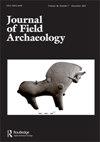Multimodal Remote Sensing Applications in the Etruscan-Roman City of Vulci
IF 1.5
1区 历史学
0 ARCHAEOLOGY
引用次数: 0
Abstract
ABSTRACT Vulci (Viterbo Province, Italy) was one of the most important Etruscan city-states in the 1st millennium b.c. and became a Roman city in 280 b.c. The habitation site had over 1500 years of continuous life and a very large funerary area around the volcanic plateau. An international research cooperation investigated the site in 2014–2019 using remote sensing technologies and conducting archaeological excavations in the urban area. This paper presents the integrated application of remote sensing methods, which include multispectral unmanned aerial vehicles, aerial photography, and high-resolution georadar measurements. The multimodal application of active and passive sensors permitted a multilayered identification of archaeological features and led to substantial new interpretations of the rich archaeological landscape, which calls for a reconsideration of traditional scholarly narratives of Vulci’s history.多模式遥感在伊特鲁里亚罗马城市武尔奇的应用
武尔奇(意大利Viterbo省)是公元前一千年伊特鲁里亚最重要的城邦之一,公元前280年成为罗马城市。这里有1500多年的连续生命,火山高原周围有一个非常大的墓地。2014-2019年,一项国际研究合作利用遥感技术对该遗址进行了调查,并在城市地区进行了考古发掘。本文介绍了遥感方法的综合应用,包括多光谱无人机、航空摄影和高分辨率地质雷达测量。主动和被动传感器的多模式应用允许对考古特征进行多层次的识别,并对丰富的考古景观产生了实质性的新解释,这需要重新考虑Vulci历史的传统学术叙事。
本文章由计算机程序翻译,如有差异,请以英文原文为准。
求助全文
约1分钟内获得全文
求助全文
来源期刊

JOURNAL OF FIELD ARCHAEOLOGY
ARCHAEOLOGY-
CiteScore
4.60
自引率
5.30%
发文量
29
期刊介绍:
The Journal of Field Archaeology is an international, refereed journal serving the interests of archaeologists, anthropologists, historians, scientists, and others concerned with the recovery and interpretation of archaeological data. Its scope is worldwide and is not confined to any particular time period. Contributions in English are welcomed from all countries.
 求助内容:
求助内容: 应助结果提醒方式:
应助结果提醒方式:


